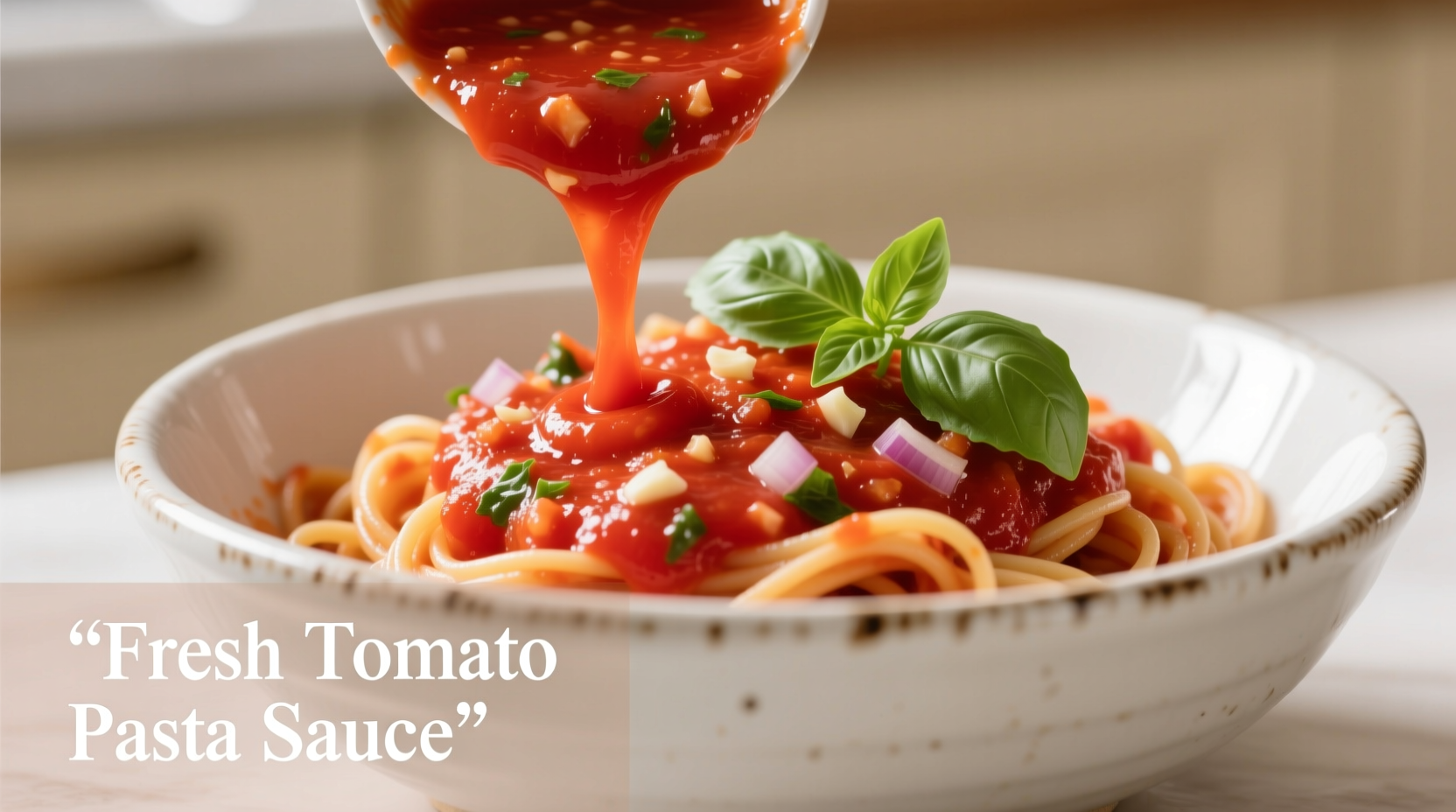Make a delicious homemade tomato pasta sauce in just 25 minutes with 6 simple ingredients: canned tomatoes, garlic, olive oil, salt, pepper, and fresh basil. This easy tomato pasta sauce recipe delivers restaurant-quality flavor without hours of simmering, perfect for weeknight dinners when you want authentic Italian taste with minimal effort.
Forget jarred sauces filled with preservatives and sugar. This streamlined tomato pasta sauce method gives you control over ingredients while delivering deep, complex flavors that taste like they simmered all day. As a chef who's cooked in both Michelin-starred kitchens and home settings, I've perfected this technique to maximize flavor with minimal active time.
Why This Easy Tomato Pasta Sauce Actually Works
Most "quick" tomato sauce recipes sacrifice depth for speed, but this method leverages food science principles to build flavor efficiently. The key is understanding how to properly caramelize tomato solids without burning them, which creates the rich umami base that makes sauces taste complex. According to research from the Culinary Institute of America, properly concentrated tomato paste develops over 40 distinct flavor compounds that mimic long-simmered sauces.

The Essential Ingredients (And Why Each Matters)
Quality ingredients make the difference between a good sauce and a great one. Here's what you need and why:
| Ingredient | Why It Matters | Substitution Options |
|---|---|---|
| Canned whole peeled tomatoes | Higher quality than diced; less processing preserves flavor | No substitutions recommended |
| Tomato paste | Concentrated flavor base for depth | None - essential for quick sauce development |
| Extra virgin olive oil | Carries flavor compounds; adds richness | Regular olive oil (less flavor) |
| Fresh garlic | Provides aromatic foundation | 1/2 tsp garlic powder (less ideal) |
Your Step-by-Step Cooking Timeline
Follow this precise sequence for maximum flavor with minimal effort. Total time: 25 minutes.
- 0-5 minutes: Heat 2 tbsp olive oil in a heavy-bottomed pan over medium heat. Add 2 tbsp tomato paste and cook, stirring constantly, until it darkens slightly ("kisses the bottom of the pan"). This Maillard reaction creates complex flavors.
- 5-8 minutes: Add 3 minced garlic cloves and cook until fragrant (about 30 seconds). Don't let garlic brown.
- 8-15 minutes: Pour in two 28-ounce cans of whole peeled tomatoes (with juices). Use kitchen scissors to cut tomatoes directly in the pan. Add 1 tsp salt, 1/4 tsp black pepper, and optional red pepper flakes.
- 15-25 minutes: Simmer uncovered, stirring occasionally, until sauce reaches desired thickness. Crush remaining whole tomatoes against the pan with a wooden spoon.
- 25 minutes: Remove from heat. Stir in 1/4 cup fresh basil. Taste and adjust seasoning.
When This Recipe Works Best (And When It Doesn't)
This easy tomato pasta sauce shines in specific contexts but has limitations:
- Perfect for: Weeknight dinners, beginners, when fresh tomatoes aren't in season, quick meal prep
- Not ideal for: When you have 4+ hours to simmer, when heirloom tomatoes are abundant in summer, special occasions requiring ultra-complex sauces
- Food safety note: Always refrigerate leftovers within 2 hours. According to USDA guidelines, cooked tomato sauce remains safe for 5-7 days when properly stored.
Customize Your Sauce Like a Pro
Once you've mastered the base recipe, these simple additions create restaurant-quality variations:
- Creamy tomato sauce: Stir in 1/4 cup heavy cream at the end
- Meat sauce: Brown 1/2 lb ground beef or Italian sausage before adding tomato paste
- Arrabbiata: Add 1 tsp red pepper flakes with the garlic
- Garden vegetable: Sauté 1/2 cup diced carrots and celery with the garlic
Serving and Storage Tips
For best results, always toss your sauce with cooked pasta in the pan for 1-2 minutes before serving. This allows the pasta to absorb sauce flavors. Add a splash of pasta cooking water to help the sauce cling to noodles.
Store cooled sauce in airtight containers:
- Refrigerator: Up to 7 days
- Freezer: Up to 6 months (portion in ice cube trays for single servings)
Frequently Asked Questions
Can I use fresh tomatoes instead of canned for this quick sauce?
Yes, but with adjustments. You'll need about 3 pounds of ripe tomatoes, peeled and seeded. Fresh tomatoes contain more water, so extend the simmering time by 10-15 minutes to achieve proper thickness. Canned tomatoes actually provide more consistent flavor year-round as they're processed at peak ripeness.
Why does my quick tomato sauce taste too acidic?
Tomato acidity is common in quick sauces. Fix it by adding a small pinch of baking soda (1/8 tsp) or a teaspoon of sugar. The baking soda neutralizes acid without adding sweetness. Alternatively, a Parmesan cheese rind simmered in the sauce adds natural umami that balances acidity.
How can I make this sauce gluten-free and vegan?
This basic recipe is naturally both gluten-free and vegan as written. Just ensure your canned tomatoes don't contain any additives (check labels). For vegan Parmesan topping, blend 1/4 cup cashews with 2 tbsp nutritional yeast, 1/4 tsp garlic powder, and salt.
Can I double this easy tomato pasta sauce recipe?
Absolutely. When doubling, use a wider pan rather than a deeper one to maintain proper evaporation. Increase tomato paste to 4 tablespoons and extend the initial cooking time by 2-3 minutes to properly caramelize the extra paste. Don't double the salt initially - add more at the end after tasting.











 浙公网安备
33010002000092号
浙公网安备
33010002000092号 浙B2-20120091-4
浙B2-20120091-4